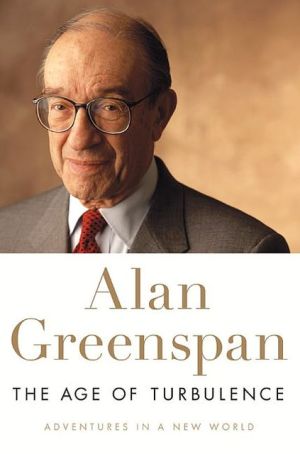

 |

|

The average rating for The Age of Turbulence: Adventures in a New World based on 2 reviews is 2 stars.
Review # 1 was written on 2018-03-09 00:00:00 Ryan Sharp Ryan SharpNot very fond of economics but this book provided a perspective on how decisions were made after 9/11. Blog | YouTube | Instagram | Facebook | LinkedIn |
Review # 2 was written on 2007-10-22 00:00:00 Jeffrey Brown Jeffrey BrownBlaise Pascal apologized to a correspondent for a long letter because he didn't have time to make it short. Alan Greenspan may have been similarly constrained. The Age of Turbulence consists of three main parts in its 505 pages. The first half is an autobiography where we learn of his New York roots, his love of music and the development of the economic analyst and political entrepreneur. Next are chapters reviewing the economic development of China, India, Russia and Latin America. The final chapters are devoted to Greenspan's view of the "big themes," including education, an aging demographic, corporate governance and energy. The autobiographical material is smartly paced, but drops more names than page 6 of the New York Post. Many lines are devoted to his active social life. For example, in the early days of his relationship with Andrea Mitchell, he tells of having to turn down her invitation to a Washington press black tie event because he was already going with Barbara Walters. Swell. The major disappointments come from the balance of the book where too often he paints with a very wide brush. As an example, he asserts that Amaranth's failure in 2006 didn't cause the problems of LTCM's collapse because our free markets had become better risk shifters over eight years. He omits the fact that virtually all investment banks and broker dealers in 1998 held similar positions to LTCM, while very few people were exposed to Amaranth's natural gas positions. The financial dominoes were lined up in 1998 for a massive fall that the Fed avoided. If 2007's liquidity events had happened before the book went to press, the truth could not have been side stepped. Similar blurring of details surrounds the 1987 Crash and other major events of Greenspan's tenure. But more disappointing is the hyperbole that one simply cannot believe. In the chapter on governance, he begins by stating he had never seen a company "fall from icon to pariah to virtual nonexistence so quickly" as when the market stopped extending credit to Enron. Was he asleep at the helm when Drexel, a most venerated and successful brokerage house went bankrupt almost overnight after it faced RICO charges and lost the confidence of its creditors? One finds it impossible to believe Greenspan's grasp of these events is as loose as it appears. Perhaps these generalizations were meant to appeal to a broader target audience than professional economists, bankers, or market participants. If that is true, however, then one struggles to understand how Chapter 18, Current Accounts and Debt, ever made the final cut. Reciting lists of statistics so numbingly dull that his various Congressional testimonies almost sound pithy, Greenspan tries to demonstrate how deficits (probably) matter. Unfortunately, by the time we follow the logic and the data, we lose sight of why we should care about the problem. In the end, we are left with a flawed book by a talented, if honorable, man. Individuals named seem to include only "friends" and "close friends." Perhaps this was done because a gentleman, having little good to say about someone, says nothing at all. But there are many invisible actors in this history, including at least a couple of Vice Chairmen at the Fed, who are today wondering whether they actually went to work for all those years. This is, without a doubt, the only shot we'll get from Greenspan. That is too bad. Many would rather have seen a detailed look of what it was like to run the Fed for almost two decades. That is something from which we could have learned. This history is way too shallow to afford a true understanding of events. And for those who are looking for the libertarian case for economic growth, go back to Friedman's Capitalism and Freedom or almost anything by Hayek. Both of those great minds spent the time necessary to write the proverbial short letter. |
CAN'T FIND WHAT YOU'RE LOOKING FOR? CLICK HERE!!!